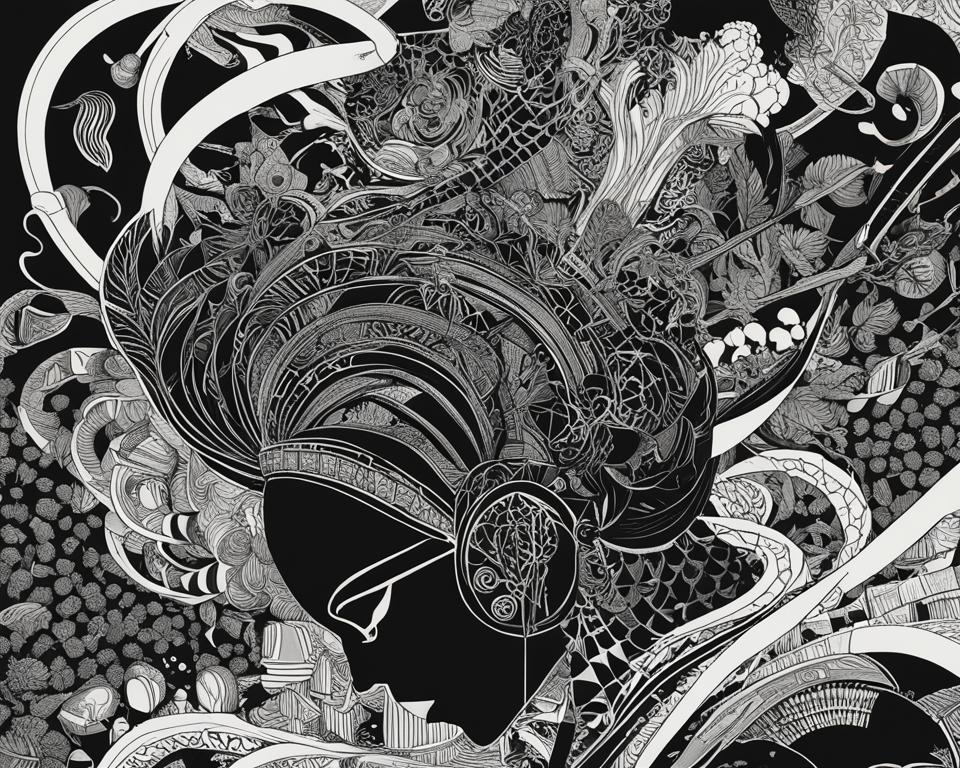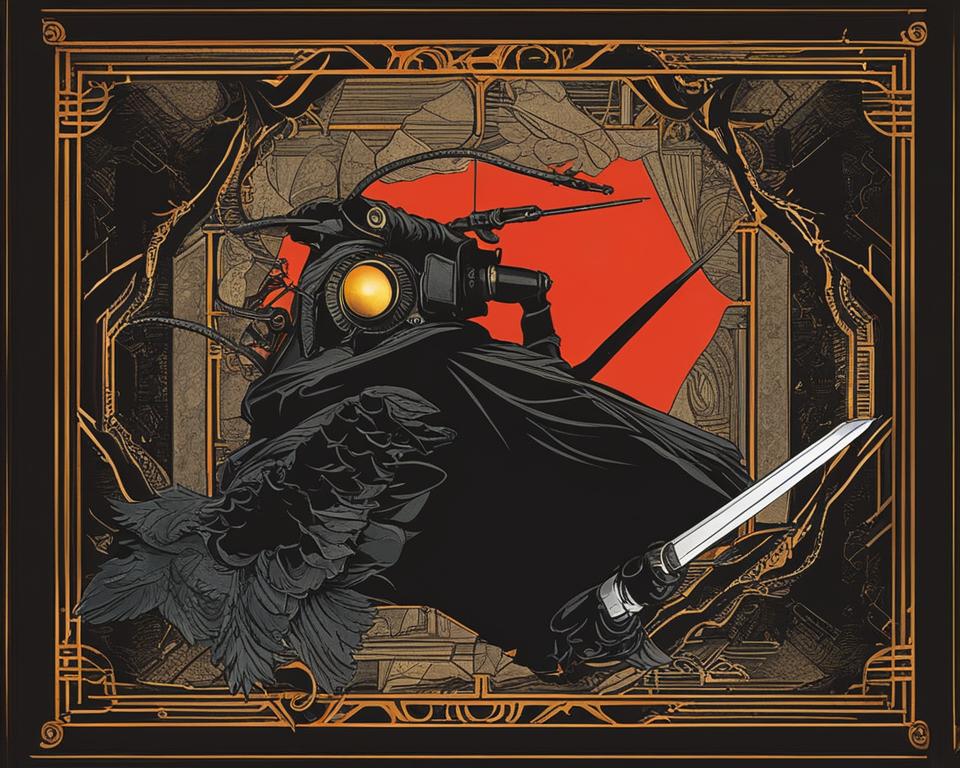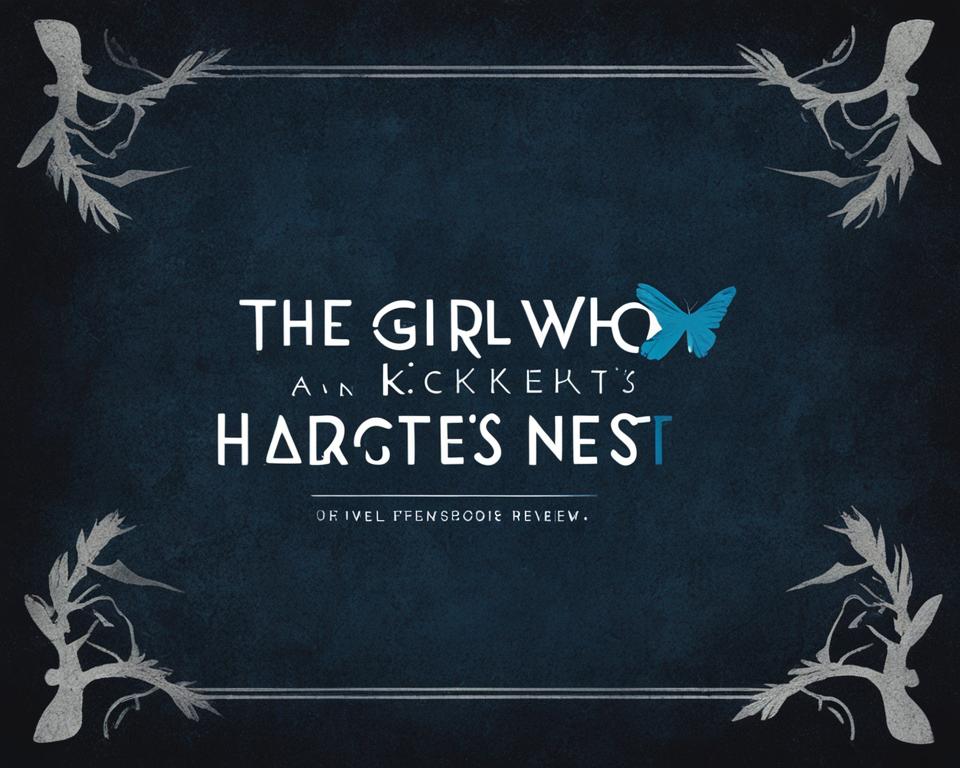In this audiobook review, we dive into the thrilling finale of Stieg Larsson’s Millennium series, The Girl Who Kicked the Hornet’s Nest. As the third book in the series, it follows the adventures of hacker Lisbeth Salander and journalist Mikael Blomkvist as they uncover high-level corruption and work to clear Lisbeth’s name from false accusations. This audiobook version, narrated by Saul Reichlin, brings the story to life in a new way. Read on to discover our thoughts on this captivating audiobook.
Key Takeaways
- The Girl Who Kicked the Hornet’s Nest is the thrilling and satisfying finale to Stieg Larsson’s Millennium series, following the adventures of beloved characters Lisbeth Salander and Mikael Blomkvist.
- This audiobook version, narrated by Saul Reichlin, gives the story a new life and allows listeners to experience the intricate plot and complex characters in a new way.
- The audiobook’s pacing and suspenseful moments keep listeners engaged and invested in the story throughout.
- The book’s exploration of themes such as corruption, gender inequality, and power dynamics make it a thought-provoking addition to the crime fiction genre.
- Overall, The Girl Who Kicked the Hornet’s Nest audiobook is highly recommended for fans of the Millennium series and anyone looking for an exciting and thought-provoking listen.
About the Author, Stieg Larsson
Stieg Larsson was a Swedish author and journalist born in 1954. After being expelled from high school, he started his career as a graphic designer, later becoming a journalist and editor of the anti-racist magazine, Expo.
Larsson’s passion for crime fiction inspired him to write his own novels, beginning with “The Girl with the Dragon Tattoo” in 2005. The book became an international bestseller, and its success led to two sequels, “The Girl Who Played with Fire” and “The Girl Who Kicked the Hornet’s Nest.”
Larsson’s writing style is characterized by his attention to detail and intricate plotting, as well as his focus on social justice issues, particularly violence against women and corruption within the government. His work has had a significant impact on the crime fiction genre, influencing writers around the world to tackle topical issues in their own writing.
Stieg Larsson’s Impact on Crime Fiction
The Millennium series, written by Larsson, has received critical acclaim worldwide, with millions of copies sold and translations in over 40 languages. The series explores themes of misogyny, political corruption, and abuse of power, all while keeping readers engaged with its fast-paced plot.
Larsson’s writing, however, unfortunately ended prematurely; he died of a heart attack in 2004, before the publication of his novels. Yet, his legacy endures, and his books still fly off the shelves, in bookstores around the world, due to storytelling that never goes out of style.
The Millennium Series Overview
The Millennium series, authored by Swedish journalist and writer Stieg Larsson, is a cornerstone in the crime fiction genre. The series consists of three novels: “The Girl with the Dragon Tattoo,” “The Girl Who Played with Fire,” and “The Girl Who Kicked the Hornet’s Nest.” All three novels follow the complex and intricate character of Lisbeth Salander, as she becomes embroiled in various criminal cases in Sweden.
The series delves into themes such as corruption, misogyny, and sexual violence, and features an array of compelling characters. Larsson’s crime fiction series stands out for its female protagonist, Lisbeth, who is strong-willed, fiercely independent, and skilled in computer hacking.
In “The Girl with the Dragon Tattoo,” readers are introduced to journalist Mikael Blomkvist and Lisbeth Salander, who work together to uncover corruption in a wealthy family. The sequel, “The Girl Who Played with Fire,” follows Lisbeth’s story as she is accused of murders and has to prove her innocence. These two books set the stage for the final installment, “The Girl Who Kicked the Hornet’s Nest,” which ties together the previous books and brings closure to Lisbeth’s story.
| Novel Title | Publication Date | Main Character |
|---|---|---|
| The Girl with the Dragon Tattoo | 2005 | Lisbeth Salander |
| The Girl Who Played with Fire | 2006 | Lisbeth Salander |
| The Girl Who Kicked the Hornet’s Nest | 2007 | Lisbeth Salander |
Overall, the Millennium series is a gripping and thought-provoking exploration of crime and corruption in Swedish society. It has become a staple in the crime fiction genre and a tribute to the late Stieg Larsson’s literary talent.
Plot Summary of “The Girl Who Kicked the Hornet’s Nest”
Continuing from the events of the previous installment, “The Girl Who Played with Fire,” Lisbeth Salander is hospitalized and recovering from her injuries. While the police and governmental officials are still pursuing her, Salander’s allies are also working to clear her name and protect her. Mikael Blomkvist, a journalist and Salander’s friend, is determined to uncover the truth about her past and present circumstances.
A shadowy division within the Swedish Security Service, known as “The Section,” is exposed as having been involved in the framing of Lisbeth. Blomkvist and his colleagues are summoned by the Swedish Secret Service for a negotiation with the officers, during which they are threatened to keep silent. However, the investigation team continues their attempts to uncover the real culprits behind The Section and to bring them to justice.
The story reaches its climax as Salander stands trial for the attempted murder of Alexander Zalachenko, the man responsible for her traumatic past, as well as for the murders of two others. As the trial progresses, new evidence emerges that exonerates her of the latter charges. Continuing to fight for justice, Salander ultimately triumphs over the corrupt officials and achieves freedom from her past traumas, leading her onto a new path.
Key Characters
| Name | Description |
|---|---|
| Lisbeth Salander | A brilliant, antisocial computer hacker and the central character of the series. |
| Mikael Blomkvist | A journalist and Salander’s friend, who works for the Millennium magazine. |
| Alexander Zalachenko | A former Soviet spy and Salander’s father, who was responsible for her traumatic past. |
| Nils Bjurman | A social worker who abused Salander and was killed in the previous novel. |
| Annika Giannini | Salander’s lawyer, who represents her in the trial. |
Throughout “The Girl Who Kicked the Hornet’s Nest,” Lisbeth Salander faces a range of challenges as she fights for justice and healing from her traumatic past. Follow her journey to its thrilling conclusion and discover the poignant themes and commentary embedded within the narrative of Stieg Larsson’s Millennium series.
Audiobook Format and Narration
The audiobook format of “The Girl Who Kicked the Hornet’s Nest” offers a unique listening experience for fans of Stieg Larsson’s crime thriller series. The narration is essential to capture the essence of the characters and enhance the storytelling experience.
The audiobook is available in the MP3 CD format, allowing for easy playback on different devices. The files are organized into relevant chapters, helping listeners to keep track of their progress through the book.
The narrator, Simon Vance, effectively captures the tone and pace of the book while providing distinct voices for the various characters. Vance’s performance enhances the listening experience, immersing the listener in the world of the Millennium series.
In conclusion, the audiobook format of “The Girl Who Kicked the Hornet’s Nest” provides an excellent way to experience the thrilling finale of Stieg Larsson’s acclaimed series. Simon Vance’s narration is superb and adds to the overall listening experience.
Character Development and Relationships
One of the most significant strengths of “The Girl Who Kicked the Hornet’s Nest” is the nuanced character development that Stieg Larsson delivers throughout the story. At the heart of the novel is a focus on the brilliant and complex character of Lisbeth Salander. Her journey throughout the series, from a misunderstood and traumatized young woman to a fierce and independent force of nature, is a testament to the depth of Larsson’s writing and his commitment to creating memorable and layered characters.
In “The Girl Who Kicked the Hornet’s Nest,” Salander’s relationships with the people around her continue to evolve. Most notably, her partnership with journalist Mikael Blomkvist takes center stage as they work together to uncover the truth about the corrupt government officials and shadowy organizations that threaten her safety and her freedom. Their dynamic relationship is a highlight of the novel and showcases the power of trust and loyalty in the face of adversity.
Lisbeth’s Growth
Throughout the novel, Lisbeth Salander’s growth as a character is on full display. Her journey from a traumatized and reclusive young woman to an empowered and confident individual is both compelling and inspiring. The struggles she faces as a result of her past traumas are handled with sensitivity and nuance, and her resilience in the face of adversity is a testament to the strength of her character.
The Importance of Relationships
In addition to Lisbeth’s own journey, the novel also explores the significance of relationships in shaping our lives. From the friendships and partnerships that Lisbeth forges to the complicated family dynamics that shape the lives of the novel’s other characters, “The Girl Who Kicked the Hornet’s Nest” is a powerful exploration of the connections that bind us to one another.
Themes and Social Commentary
Stieg Larsson’s writing is known for its exploration of complex themes and social commentary. “The Girl Who Kicked the Hornet’s Nest” is no exception, with Larsson shining a light on corruption, gender inequality, and power dynamics within society.
The Girl Who Kicked the Hornet’s Nest delves into the corrupt systems of power within the Swedish government and how they impact the lives of ordinary citizens. Larsson’s commentary on political and societal corruption is thought-provoking and remains relevant today, making the book a valuable piece of social commentary.
Gender Inequality
The novel also touches on gender inequality and discrimination faced by women in both personal and professional spheres. Lisbeth Salander, the protagonist of the Millennium series, faces gender-based violence and discrimination from a young age, highlighting the rampant misogyny in society.
Larsson’s portrayal of strong, independent female characters like Lisbeth Salander and Erika Berger challenges traditional gender roles and undermines gender-based stereotypes. This makes the book an important commentary on gender issues and empowers readers to question and challenge societal norms.
Power Dynamics within Society
Additionally, the book sheds light on the power dynamics within society, with characters from different social classes and backgrounds struggling for power and control. Larsson uses the characters and their relationships to showcase the complexities of power dynamics and their impact on society.
Overall, Stieg Larsson’s exploration of themes and social commentary in “The Girl Who Kicked the Hornet’s Nest” adds depth and relevance to the novel, making it more than just a thrilling read.
Pacing and Suspense
Stieg Larsson masterfully builds up the pacing and suspense in “The Girl Who Kicked the Hornet’s Nest,” creating a thrilling and engaging listening experience. From the start, readers are immediately drawn into the story, with the tension only increasing as the plot unfolds.
Larsson’s attention to detail adds to the sense of urgency and suspense throughout the audiobook. Every scene and subplot is crafted to keep listeners on the edge of their seats, wondering what will happen next. Whether it’s the high-stakes courtroom drama or the heart-pumping action scenes, the pacing is perfectly balanced to maintain momentum and keep the story moving forward.
The use of multiple perspectives also adds to the suspense, allowing readers to see events unfold from different angles and emphasizing the complexity of the plot. As the storylines converge towards the gripping finale, the tension reaches a fever pitch, leaving listeners unable to stop listening until the very end.
Key Takeaways:
- The pacing and suspense in “The Girl Who Kicked the Hornet’s Nest” create a thrilling listening experience.
- Larsson’s attention to detail adds to the sense of urgency and keeps the plot moving forward.
- The use of multiple perspectives emphasizes the complexity of the story and enhances the suspense.
- The tension builds towards a gripping finale that leaves listeners unable to stop listening.
Writing Style and Descriptive Language
Stieg Larsson’s writing style in “The Girl Who Kicked the Hornet’s Nest” is known for its vivid imagery and compelling storytelling. Through descriptive language, the author masterfully creates a sense of place, allowing readers to immerse themselves in the world of Lisbeth Salander and Mikael Blomkvist.
Larsson’s writing is straightforward and concise, yet rich in detail. He skillfully weaves together complex plotlines while maintaining a fast pace, keeping readers engaged from start to finish. His prose is also known for its ability to evoke emotional responses from readers, allowing them to empathize with the characters and their struggles.
One example of Larsson’s use of descriptive language can be seen in his portrayal of the Swedish landscape. In one passage, he writes:
“The landscape of northern Sweden was as beautiful as it was desolate. The sky was a light blue-gray, and the forests and fields were covered in a layer of fresh snow that glittered in the sunlight. The only sounds were the crunching of our boots in the snow and the occasional call of a bird.”
This passage not only sets the scene but also creates a mood of both beauty and isolation. Larsson’s ability to paint a vivid picture with his words is a testament to his skill as a writer.

Critical Reception and Awards
Since its release, The Girl Who Kicked the Hornet’s Nest has received immense critical acclaim, solidifying Stieg Larsson’s legacy as a master of the crime fiction genre. The book has an average rating of 4.24 stars out of 5 on Goodreads and 4.4 out of 5 on Amazon.
The book’s gripping plot, dynamic characters, and social commentary have received widespread praise from critics and readers alike. The Guardian describes it as “an intricately plotted nail-biter” while The New York Times hails it as “a tense, tightly plotted tale”.
Larsson’s final installment in the Millennium series has also been recognized with numerous awards, cementing its place as a standout in the crime fiction genre. In 2010, it won the Best Crime Novel award at the Specsavers Crime Thriller Awards and was nominated for the Barry Award for Best Thriller.
| Publication | Rating | Excerpt from Review |
|---|---|---|
| The Guardian | 5/5 | “The neatly plotted narrative allows breathing space for Salander to take centre stage, and confirms her as one of the great fictional creations of our times.” |
| The New York Times | Positive | “For those who have followed Larsson’s carefully plotted series, this book answers many questions about his death, leaves others tantalizingly unanswered and is undoubtedly the darkest and most political of the three.” |
| Publishers Weekly | Positive | “The novel is complex, involving, and – above all – rewarding. There are readers who will be tempted to race through the book, but those who do will miss more than they will capture.” |
Comparison to Previous Books in the Millennium Series
How does “The Girl Who Kicked the Hornet’s Nest” compare to the previous books in the Millennium series? Let’s take a look at some key factors:
| “The Girl with the Dragon Tattoo” | “The Girl Who Played with Fire” | “The Girl Who Kicked the Hornet’s Nest” | |
|---|---|---|---|
| Storytelling | Introduces characters and overarching themes | Builds on previous book and introduces new elements | Concludes overarching storylines |
| Character Development | Focuses on Mikael Blomkvist | Explores Lisbeth Salander’s backstory | Continues to develop Lisbeth while adding depth to secondary characters |
| Themes | Introduces themes of dark family secrets and corruption | Explores the sex trade and underworld crime | Addresses issues of corruption and gender inequality within government and society |
| Pacing and Suspense | Slow buildup with a dramatic conclusion | Keeps readers engaged with high stakes and fast-paced action | Consistently thrilling with intense courtroom scenes |
“The Girl Who Kicked the Hornet’s Nest” may be the most satisfying entry in the series for readers who have followed the journey of Lisbeth Salander and Mikael Blomkvist from the beginning. The novel masterfully concludes previous plot points while also adding new layers to the characters and themes. Its fast-paced storytelling and engaging courtroom scenes make it a standout in the series.
Impact and Legacy
Stieg Larsson’s Millennium series, including “The Girl Who Kicked the Hornet’s Nest,” has had a significant impact on the crime fiction genre. The series has been praised for its complex characters, intricate plots, and its exploration of social issues, including gender inequality and corruption.
The legacy of the Millennium series is evident in the continued popularity of the books today, as well as the numerous adaptations and spin-offs that have been released in the years since their initial publication. The characters of Lisbeth Salander and Mikael Blomkvist have become cultural icons, and the series has been an inspiration for many writers in the crime fiction genre.
The impact and legacy of the Millennium series can also be seen in its critical reception and awards. “The Girl Who Kicked the Hornet’s Nest” was a New York Times bestseller and won several awards, including Sweden’s Glass Key Award for Best Crime Novel of the Year.
Recommendations and Conclusion
After a thorough audiobook review of Stieg Larsson’s “The Girl Who Kicked the Hornet’s Nest,” we recommend this gripping finale to fans of the Millennium series and lovers of crime fiction. The audiobook format enhances the storytelling experience, and the narration by Simon Vance effectively captures the essence of the characters.
The strengths of the audiobook include the satisfying conclusion to Lisbeth Salander’s story, the intricate character development and relationships, and the underlying themes of corruption and power dynamics in society. Additionally, the pacing and suspense keep listeners engaged throughout the audiobook.
However, the audiobook may not be suitable for all listeners due to its mature themes and graphic content. Some listeners may also find the detailed descriptions and slow build-up tedious.
In conclusion, we highly recommend “The Girl Who Kicked the Hornet’s Nest” audiobook for a thrilling and thought-provoking listening experience. It’s a fitting conclusion to Stieg Larsson’s legacy and an impactful addition to the crime fiction genre.

Bonus Content and Related Works
For those who can’t get enough of Stieg Larsson’s work, there is plenty of bonus content and related works to explore. One such work is “The Girl in the Spider’s Web,” a continuation of the Millennium series written by David Lagercrantz following Larsson’s death.
Additionally, fans can discover “The Girl Who Played with Fire” and “The Girl with the Dragon Tattoo,” the previous books in the Millennium series written by Larsson himself. These books offer a deeper understanding of the series’ overarching themes and characters.
For those interested in the adaptation of the Millennium series, both Swedish and American film adaptations are available, as well as a television series. These adaptations offer an alternate viewing experience for fans who want to see the story come to life on screen.
Overall, there is plenty of bonus content and related works to satisfy fans of Stieg Larsson and the Millennium series. With the continued popularity and cultural impact of these books, it’s clear that their legacy will endure for years to come.
FAQ
Can I listen to “The Girl Who Kicked the Hornet’s Nest” as an audiobook?
Yes, “The Girl Who Kicked the Hornet’s Nest” is available in audiobook format.
Who is the author of “The Girl Who Kicked the Hornet’s Nest”?
“The Girl Who Kicked the Hornet’s Nest” is written by Stieg Larsson.
What is the Millennium series?
The Millennium series is a crime fiction series authored by Stieg Larsson.
What is the plot summary of “The Girl Who Kicked the Hornet’s Nest”?
“The Girl Who Kicked the Hornet’s Nest” continues the story of Lisbeth Salander as she fights for justice while recovering from her past traumas.
How is the audiobook format and narration in “The Girl Who Kicked the Hornet’s Nest”?
The audiobook format enhances the storytelling experience, and the narrator effectively captures the essence of the characters.
What is the character development like in “The Girl Who Kicked the Hornet’s Nest”?
“The Girl Who Kicked the Hornet’s Nest” explores the growth and complexities of the characters, particularly Lisbeth Salander and her dynamic relationships.
What themes and social commentary are present in “The Girl Who Kicked the Hornet’s Nest”?
“The Girl Who Kicked the Hornet’s Nest” delves into themes of corruption, gender inequality, and power dynamics within society.
How is the pacing and suspense in “The Girl Who Kicked the Hornet’s Nest”?
“The Girl Who Kicked the Hornet’s Nest” maintains a gripping pace and keeps readers on the edge of their seats with its suspenseful plot.
What is the writing style and use of descriptive language like in “The Girl Who Kicked the Hornet’s Nest”?
Stieg Larsson’s writing style in “The Girl Who Kicked the Hornet’s Nest” is characterized by vivid descriptions and the ability to evoke emotional responses from readers.
How was “The Girl Who Kicked the Hornet’s Nest” critically received, and has it won any awards?
“The Girl Who Kicked the Hornet’s Nest” has received positive critical reception and has won various awards in the crime fiction genre.
How does “The Girl Who Kicked the Hornet’s Nest” compare to the previous books in the Millennium series?
“The Girl Who Kicked the Hornet’s Nest” is the thrilling finale of the Millennium series and is compared to the previous books in terms of storytelling, character development, and overall satisfaction.
What is the impact and legacy of “The Girl Who Kicked the Hornet’s Nest” and the Millennium series?
“The Girl Who Kicked the Hornet’s Nest” and the Millennium series have had a significant impact on the crime fiction genre and continue to be popular among readers worldwide.
What recommendations can you provide based on the audiobook review of “The Girl Who Kicked the Hornet’s Nest”?
Based on our audiobook review, “The Girl Who Kicked the Hornet’s Nest” comes highly recommended for its engaging storytelling and captivating narration.
Is there any bonus content or related works associated with “The Girl Who Kicked the Hornet’s Nest”?
There may be bonus content or related works, such as companion novels or adaptations, available in connection with “The Girl Who Kicked the Hornet’s Nest” and the Millennium series.



